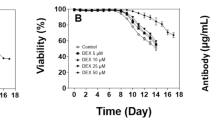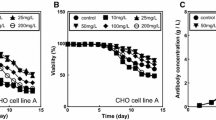Summary
Hyperosmotic pressure increased specific antibody productivity (q Ab) of recombinant Chinese hamster ovary (rCHO) cells (SH2-0.32) and it depressed cell growth. Thus, the use of hyperosmolar medium did not increase the maximum antibody concentration substantially. To overcome this drawback, the feasibility of biphasic culture strategy was investigated. In the biphasic culture, cells were first cultivated in the standard medium with physiological osmolality (294 mOsm/kg) for cell growth. When cells reached the late exponential growth phase, the spent standard medium was replaced with the fresh hyperosmolar medium (522 mOsm/kg) for antibody production. The q Ab in growth phase with the standard medium was 2.1 μg per 106 cells/d, whereas the q Ab in antibody production phase with the hyperosmolar medium was 11.1 μg per 106 cells/d. Northern blot analysis showed a positive relationship between the relative contents of intracellular immunoglobulin messenger ribonucleic acid and q Ab. Because of the enhanced q Ab and the increased cell concentration in biphasic culture, the maximum antibody concentration obtained in biphasic culture with 522 mOsm/kg medium exchange was 161% higher than that obtained in batch culture with the standard medium. Taken together, the simple biphasic culture strategy based on hyperosmotic culture is effective in improving antibody production of rCHO cells.
Similar content being viewed by others
References
Bresnahan, W. A.; Boldogh, I.; Thompson, E. A.; Albrecht, T. Human cytomegalovirus inhibits cellular DNA synthesis and arrests productively infected cells in late G1. Virology 224:150–160; 1996.
Chen, Z.; Liu, H.; Wu, B. Hyperosmolality leads to an increase in tissue-type plasminogen activator production by a Chinese hamster ovary cell line. Biotechnol. Tech. 12:207–209; 1998.
Cherlet, M.; Marc, A. Hybridoma cell behavior in continuous culture under hyperosmotic stress. Cytotechnology 29:71–84; 1999.
Dittmer, D.; Mocarski, E. S. Human cytomegalovirus infection inhibits G1/S transition. J. Virol. 71:1629–1634; 1997.
Hong, H. J.; Kim, A. K.; Ryu, C. J., et al. Cloning and characterization of cDNAs coding for heavy and light chains of a monoclonal antibody specific for pre-S2 antigen of hepatitis B virus. Gene 121:331–335; 1992.
Kim, J. H.; Bae, S. W.; Hong, H. J.; Lee, G. M. Decreased chimeric antibody productivity of KR12H-1 transfectoma during long-term culture results from decreased antibody gene copy number. Biotechnol. Bioeng. 51:479–487; 1996.
Kim, N. S. Enhancement of foreign protein productivity in recombinant CHO cells by inhibition of cellular apoptosis under various stress conditions. Ph.D. dissertation. korea Advanced Institute of Science and Technology, Taejon, South Korea; 2001.
Kim, T. K.; Chung, J. Y.; Sung, Y. H.; Lee, G. M. Relationship between cell size and specific thrombopoietin productivity in Chinese hamster ovary cells during dihydrofolate reductase-mediated gene amplification. Biotechnol. Bioprocess Eng. 6:332–336; 2002.
Kim, T. K.; Ryu, J. S.; Chung, J. Y.; Kim, M. S.; Lee, G. M. Osmoprotective effect of glycine betaine on thrombopoietin production in hyperosmotic Chinese hamster ovary cell culture: clonal variations. Biotechnol. Prog. 16:775–781; 2000.
Lee, G. M.; Park, S. Y. Enhanced specific antibody productivity of hybridomas resulting from hyperosmotic stress is cell line specific. Biotechnol. Lett. 17:145–150; 1995.
Lee, G. M.; Varma, A.; Palsson, B. O. Production of monoclonal antibody using free-suspended and immobilized hybridoma cells: effect of serum. Biotechnol. Bioeng. 38:821–830; 1991.
Lee, M. S.; Lee, G. M. Hyperosmotic pressure enhances immunoglobulin transcription rates and secretion rates of KR12H-2 transfectoma. Biotechnol. Bioeng. 68:260–268; 2000.
Oh, S. K. W.; Chua, F. K. F.; Choo, A. B. H. Intracellular responses of productive hybridomas subjected to high osmotic pressure. Biotechnol. Bioeng. 46:525–535; 1995.
Øyaas, K.; Ellingsen, T. E.; Dyrset, N.; Levine, D. W. Utilization of osmoprotective compounds by hybridoma cells exposed to hyperosmotic stress. Biotechnol. Bioeng. 43:77–89; 1994a.
Øyaas, K.; Ellingsen, T. E.; Dyrset, N.; Levine, D. W. Hyperosmotic hybridoma cell cultures: increased monoclonal antibody production with addition of glycine betaine. Biotechnol. Bioeng. 44:991–998; 1994b.
Ozturk, S. S.; Palsson, B. O. Effect of medium osmolality on hybridoma growth, metabolism, and antibody production. Biotechnol. Bioeng. 37:989–993; 1991.
Reddy, S.; Miller, W. M. Effects of abrupt and gradual osmotic stress on antibody production and content in hybridoma cells that differ in production kinetics. Biotechnol. Prog. 10:165–173; 1994.
Ryu, J. S.; Kim, T. K.; Chung, J. Y.; Lee, G. M. Osmoprotective effect of glycine betaine on foreign protein production in hyperosmotic recombinant Chinese hamster ovary cell cultures differs among cell lines. Biotechnol. Bioeng. 70:167–175; 2000.
Ryu, J. S.; Lee, G. M. Influence of hyperosomolar basal media on hybridoma cell growth and antibody production. Bioprocess Eng. 16:305–310; 1996.
Sambrook, J.; Russel, D. W. Molecular cloning. 3rd ed. New York: Cold Spring Harbor Laboratory; 2001.
Takagi, M.; Hayashi, H.; Yoshida, T. The effect of osmolality on metabolism and morphology in adhesion and suspension Chinese hamster ovary cells producing tissue plasminogen activator. Cytotechnology 32:171–179; 2000.
Waymouth, C. Determination and survey of osmolality in culture media. In: Kruse P. F.; Patterson, M. K., ed. Tissue culture: methods and application. New York: Academic Press; 1973:703–709.
Wu, Q. D.; Wang, J. H.; Fennessy, F.; Redmond, H. P.; Bouchier-Hayes, D. Taurine prevents high-glucose-induced human vascular endothelial cell apoptosis. Am. J. Physiol. 277:C1229-C1238; 1999.
Author information
Authors and Affiliations
Corresponding author
Rights and permissions
About this article
Cite this article
Kim, M.S., Kim, N.S., Sung, Y.H. et al. Biphasic culture strategy based on hyperosmotic pressure for improved humanized antibody production in Chinese hamster ovary cell culture. In Vitro Cell.Dev.Biol.-Animal 38, 314–319 (2002). https://doi.org/10.1290/1071-2690(2002)038<0314:BCSBOH>2.0.CO;2
Received:
Accepted:
Issue Date:
DOI: https://doi.org/10.1290/1071-2690(2002)038<0314:BCSBOH>2.0.CO;2




